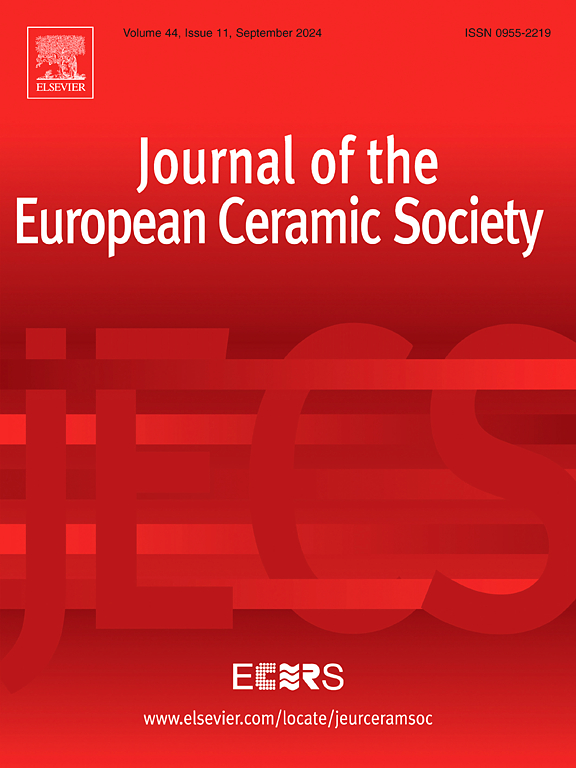La0.25Nd0.25Sm0.25Gd0.25MgAl11O19与LaMgAl11O19等离子喷涂涂层热老化行为的对比研究
IF 5.8
2区 材料科学
Q1 MATERIALS SCIENCE, CERAMICS
Journal of The European Ceramic Society
Pub Date : 2025-05-04
DOI:10.1016/j.jeurceramsoc.2025.117507
引用次数: 0
摘要
高熵LnMgAl11O19 (Ln = La, Nd, Sm, Gd;通过固相反应成功合成了LnMA和LaMgAl11O19 (LaMA)粉体。本研究主要研究了等离子喷涂LnMA涂层与LaMA涂层在热老化过程中再结晶行为的变化。结果表明,在800 ~ 1200℃的温度下,LnMA涂层中形成了多种纳米结构,包括纳米等轴晶、纳米层状晶体和高纵横比亚晶。这种行为与在LaMA涂层中观察到的再结晶形成鲜明对比。再结晶过程中晶粒尺寸的差异是由LnMA涂层中的高熵扩散延迟效应引起的,该效应显著影响了涂层的整体性能。值得注意的是,在1400℃下时效100 h后,LnMA涂层的热膨胀系数与烧结LnMA本体材料的热膨胀系数接近,超过了LaMA本体材料的热膨胀系数。这表明LnMA涂层具有优异的热物理性能和机械性能。为了进一步探讨性能差异,利用同步热分析和x射线衍射比较了LnMA和LaMA涂层的相稳定性。此外,通过扫描电镜(SEM)和纳米压痕测量研究了两种涂层在热老化过程中的显微组织和力学性能变化,特别关注了非晶涂层的再结晶机制。该研究表明,LnMA涂层在高温使用环境中具有优异的结构完整性和机械性能。本文章由计算机程序翻译,如有差异,请以英文原文为准。
Comparative investigation on the thermal aging behavior of the plasma sprayed coatings of La0.25Nd0.25Sm0.25Gd0.25MgAl11O19 and LaMgAl11O19
High-entropy LnMgAl11O19 (Ln = La, Nd, Sm, Gd; LnMA) and LaMgAl11O19 (LaMA) powders were successfully synthesized via solid-state reactions. This study primarily investigates the changes in recrystallization behavior during thermal aging of plasma-sprayed LnMA coatings compared to LaMA coatings. The results demonstrate that thermal aging at temperatures ranging from 800°C to 1200°C leads to the formation of various nanostructures in the LnMA coatings, including nano-equiaxed grains, nano-layered crystals, and high-aspect-ratio subgrains. This behavior contrasts sharply with the recrystallization observed in LaMA coatings. The differences in grain size during recrystallization are attributed to the high-entropy diffusion retardation effect in the LnMA coatings, which significantly influences the overall performance of the coatings. Notably, after aging for 100 h at 1400°C, the thermal expansion coefficient of the LnMA coatings closely matches that of sintered LnMA bulk material and exceeds that of LaMA bulk material. This indicates superior thermophysical and mechanical properties for the LnMA coatings. To further explore the performance differences, phase stability between the LnMA and LaMA coatings was compared using simultaneous thermal analysis and X-ray diffraction. Additionally, the microstructural and mechanical property changes of both coatings during thermal aging were investigated through scanning electron microscopy (SEM) and nanoindentation measurements, with a particular focus on the recrystallization mechanisms in the amorphous coatings. This study demonstrates that LnMA coatings offer superior structural integrity and mechanical performance in high-temperature service environments.
求助全文
通过发布文献求助,成功后即可免费获取论文全文。
去求助
来源期刊

Journal of The European Ceramic Society
工程技术-材料科学:硅酸盐
CiteScore
10.70
自引率
12.30%
发文量
863
审稿时长
35 days
期刊介绍:
The Journal of the European Ceramic Society publishes the results of original research and reviews relating to ceramic materials. Papers of either an experimental or theoretical character will be welcomed on a fully international basis. The emphasis is on novel generic science concerning the relationships between processing, microstructure and properties of polycrystalline ceramics consolidated at high temperature. Papers may relate to any of the conventional categories of ceramic: structural, functional, traditional or composite. The central objective is to sustain a high standard of research quality by means of appropriate reviewing procedures.
 求助内容:
求助内容: 应助结果提醒方式:
应助结果提醒方式:


